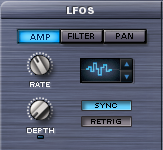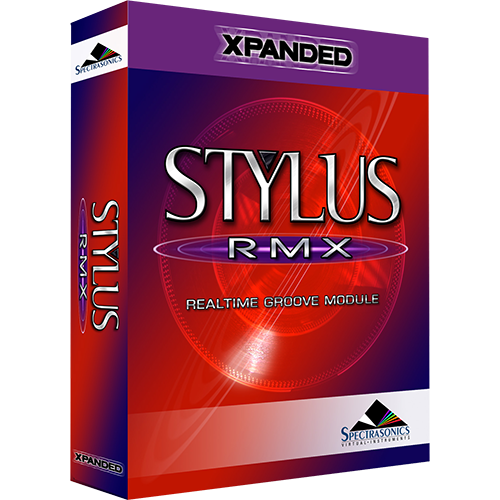
LFOs (Low Frequency Oscillators) are used for cyclical modulation effects like tremolo, filter sweeps, and auto-pan effects.
There are three completely independent LFOs: AMP, FILTER, and PAN per Edit Group. Each LFO has it’s own sub-page with a full set of dedicated controls. To activate a sub-page, click one of the three sub-page buttons:
AMP SWITCH

The Amplitude LFO modulates the volume of the audio.
FILTER SWITCH

The Filter LFO modulates the Cutoff parameter in the Power Filter section. Please note that the Power Filter MUST be engaged for the Filter LFO to work.
PAN SWITCH

The Pan LFO modulates the panning of the audio.
WAVEFORM SELECTOR
This parameter allows you to choose the waveform the LFO uses for modulation. Click the stepper arrows to scroll through the waveforms.
There are 7 waveforms to choose from:
 | Sine – A smooth c-shape that begins positive and then curves negative and back again. Useful for sweeps and vibrato. |
 | Triangle – A positive/negative-shape like the Sine, but without curvature. Useful for sweeps and vibrato. |
 | Square – Starts at maximum positive value and then drops to maximum negative value. Useful for trills and pulsing effects. |
 | Rounded Square – A smoothed Square wave. Ideal for softer pulsing. |
 | Ramp – A linear slope from highest to lowest to highest value. This waveform is also frequently referred to as a sawtooth wave. Useful for sweeps. |
 | Reverse Ramp – A linear slope from lowest to highest value. This waveform is also frequently referred to as an inverted sawtooth wave. Useful for reverse sweeps |
 | Sample and Hold – Steps through random values. Useful for analog synth effects. |
RATE KNOB

The Rate knob controls the speed of modulation and has two modes. These modes depend on the state of the Sync parameter:
- SYNC OFF – The Rate parameter freewheels and uses Cycles Per Second (CPS) to control the LFO. The knob increases CPS as it’s turned clockwise (0 – 15 CPS).
- SYNC ON – The Rate parameter uses rhythmic values along with the host’s tempo to control the LFO so that it stays in sync with the groove. Turning the knob in this mode scrolls through different note value groups. It does not simply get faster as the knob is turned clockwise. Some examples of note values found spread out around the knob:
8x – This value stretches a cycle across 8 bars.
1/8 – This value cycles the LFO every 1/8 note.
1/8 dot – This value cycles the LFO every dotted 1/8 note.
1/8 triplet – This value cycles the LFO every 1/8 note triplet.
Here is a list of all available values:
32X, 16X, 8X, 7X, 6X, 5X, 4X, 3X, 2X
1/1, 1/2, 1/4, 1/8, 1/16, 1/32, 1/64, 1/96
1/1dot, 1/2dot, 1/4dot, 1/8dot, 1/16dot
1/1triplet, 1/2triplet, 1/4triplet, 1/8triplet, 1/16triplet
DEPTH KNOB

This knob activates the LFO. When it is fully counter-clockwise, the LFO is inactive. Turning this knob clockwise controls how much modulation occurs.
- AMP sub-page: DEPTH controls how much volume change will occur, relative to the position of the Level fader.
- FILTER sub-page: DEPTH controls how much the frequency will sweep, relative to the position of the Cutoff parameter.
- PAN sub-page: DEPTH controls how much panning will occur, relative to the position of the PAN fader.
INVERT LED
This small indicator switch below the Depth knob has two modes, functioning as both an LED and a switch. Clicking the LED toggles between the 2 modes.
- The Blue LED indicates positive modulation.
- The Yellow LED indicates negative modulation.
When the LED is blue, the FILTER Depth knob controls how much the frequency opens from its original Cutoff position. When it’s yellow, the Depth knob controls how much the filter closes from its original Cutoff position.
SYNC BUTTON

This button synchronizes the LFO rate to the tempo of the host.
RETRIG BUTTON

This button restarts (retriggers) the LFO waveform at the beginning of the measure where you begin playback. This means the beginning of the cycle of the LFO will be aligned with the beginning of the measure, locking the phase of the LFO to the measures of the song.



